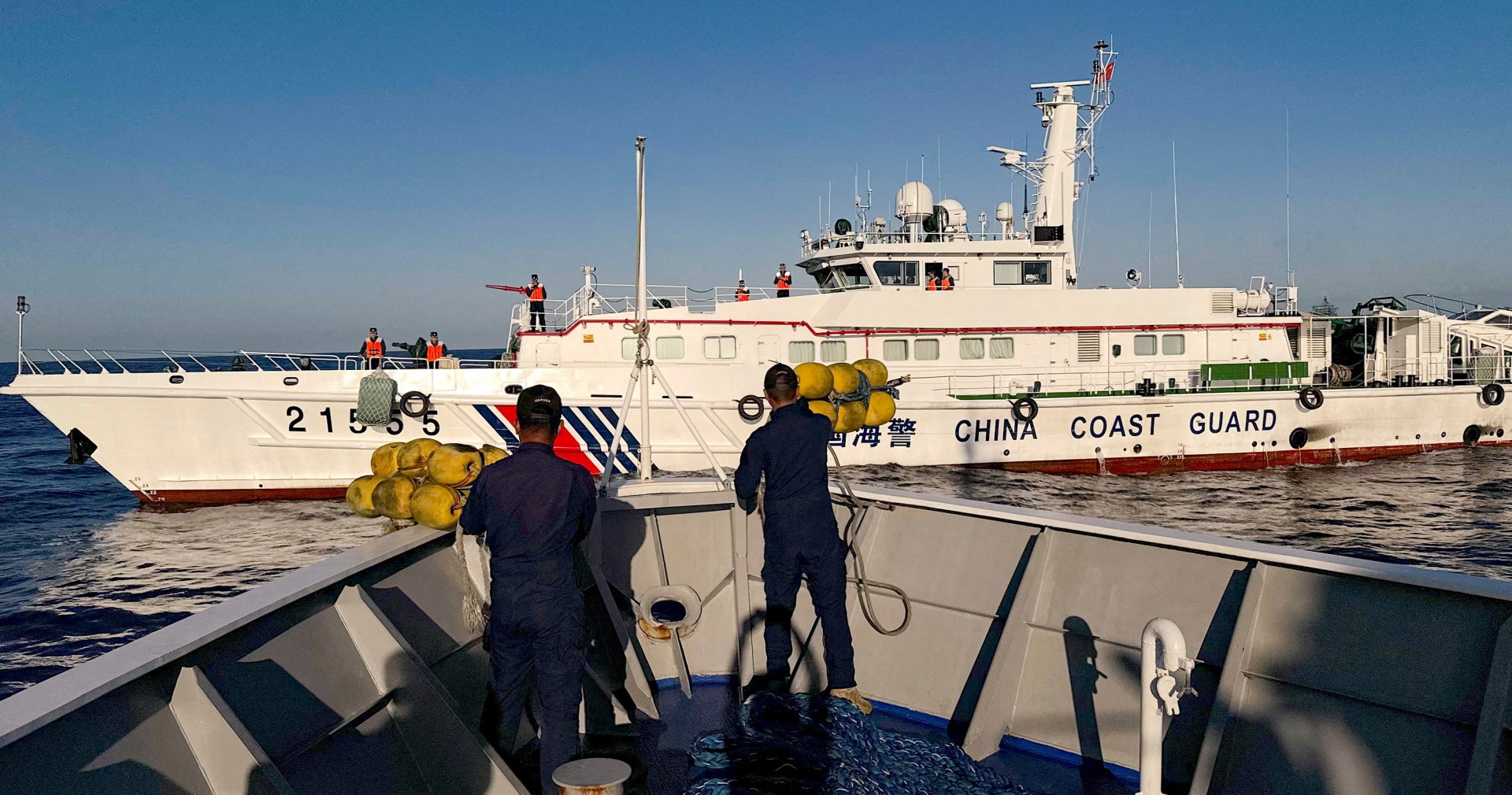The most recent confrontation marks a significant escalation in the intensifying dispute between China and the Philippines.
The Philippines has accused China’s Coast Guard of launching a “brutal assault” involving bladed weapons during a recent clash in the South China Sea, ratcheting up the stakes in an ongoing dispute that risks escalating into a broader conflict involving the United States.
Footage released by the Philippine military on Thursday shows Chinese Coast Guard officers wielding an axe and other bladed tools against Filipino soldiers. They are also seen slashing a rubber boat, which Manila has termed “a brazen act of aggression.”
The Philippines and China have traded accusations over the confrontation near the Second Thomas Shoal in the contested Spratly Islands. The incident occurred during a Philippine mission to resupply soldiers stationed on a beached World War II-era warship, asserting Manila’s territorial claims over the atoll.

This clash is the latest in a series of increasingly tense encounters in the resource-rich and strategically vital waterway. Analysts note that the latest footage marks a significant escalation, with China adopting more overtly aggressive tactics to test the responses of the Philippines and its key defence ally, the United States.
The Chinese Foreign Ministry stated on Wednesday that its coast guard’s “law enforcement measures” were “professional and restrained,” and no direct actions were taken against Philippine personnel.
Collin Koh, a research fellow at the S. Rajaratnam School of International Studies in Singapore, remarked that it was unprecedented for China’s maritime law enforcement to board a Philippine naval vessel. “They can be rubber boats, but it doesn’t change the fact that they are Philippine Navy vessels, and according to international law, they enjoy what we term as sovereign immunity,” Koh said. “That is very dangerous, because, if anything, that could even be construed as an act of war.”
During a news conference on Wednesday, senior Philippine military officials said China’s Coast Guard officers “illegally boarded” the Philippine rubber boats, “looted” seven disassembled rifles stored in gun cases, “destroyed” outboard motors, communication equipment, and navigation equipment, and even seized the personal mobile phones of Filipino personnel.

“They deliberately punctured our rubber boats using knives and other pointed tools,” stated Alfonso Torres Jr., commander of the Armed Forces of the Philippines (AFP) Western Command.
A Philippine Navy serviceman lost his right thumb when the Chinese Coast Guard rammed the boat, Torres added. Additionally, China’s Coast Guard deployed tear gas, “blinding” strobe lights, and continuously blared sirens, according to the AFP.
“Only pirates do this. Only pirates board, steal, and destroy ships, equipment, and belongings,” said General Romeo Brawner Jr., Chief of Staff of the Armed Forces of the Philippines. “The Chinese Coast Guard personnel had bladed weapons and our personnel fought with bare hands. That is what’s important. We were outnumbered and their weapons were unexpected but our personnel fought with everything that they had,” Brawner added.
The Philippines military chief has since demanded that China pay for the damages and return the Philippine weapons and equipment seized in the assault.
This is how barbaric the Chinese Coast Guard is in the recent RoRe mission of the Armed Forces of the Philippines. These videos show how blatantly they use physical attacks and violence to prevent our soldiers from completing the legitimate and humanitarian resupply mission to… pic.twitter.com/7vzFDem1DE
— Jay Tarriela (@jaytaryela) June 19, 2024
MUTUAL DEFENCE TREATY IMPLICATIONS
The events in the South China Sea carry significant implications for the United States, which has a mutual defence treaty with the Philippines dating back decades. This recent clash marks the first confrontation between the two nations since a new Chinese law took effect, authorising its coast guard to seize foreign ships and detain crews suspected of trespassing for up to 60 days without trial.
Philippine President Ferdinand “Bongbong” Marcos Jr. recently warned that the death of any Filipino citizen at the hands of another country in the waterway would be “very close” to an act of war. Marcos has pursued closer ties with the United States, which has reiterated its “iron-clad commitment” to the 1951 mutual defence treaty with the Philippines.

US State Department spokesman Matthew Miller stated on Monday, “The United States stands with its ally the Philippines and condemns the escalatory and irresponsible actions” by China. In a call with Philippine Foreign Secretary Enrique A. Manalo on Wednesday, US Secretary of State Antony Blinken said China’s actions “undermine regional peace and stability,” reaffirming the United States’ commitments to the Philippines under their mutual defence treaty.
Derek Grossman, a senior defence analyst at the RAND Corporation, noted that the footage released by the Philippines “clearly shows a Chinese attack on Philippine military assets,” which according to the US-Philippines defence pact, would trigger mutual defence commitments. “However, in practical terms, the Philippines itself would have to initiate a move to activate it before the US would intervene militarily,” he said.
China claims “indisputable sovereignty” over almost the entire South China Sea, including features hundreds of miles from its mainland. Multiple governments, including Manila, hold competing claims. An international tribunal in The Hague ruled in favour of the Philippines in a 2016 maritime dispute, concluding that China has no legal basis to claim historic rights to the bulk of the South China Sea. Beijing has ignored the ruling, continuing to push its maritime territorial claims.

PHILIPPINE ‘RESTRAINT’
China’s Coast Guard’s use of bladed weapons in the latest clash has drawn comparisons to disputes between China and India on their Himalayan border, where soldiers have fought with sticks, rocks, and their hands.
The Philippine personnel on the rubber boats, from the Navy Special Operations Group, are elite forces trained in combat. They did not retaliate, exercising restraint. “They probably have received instructions right from the top that under whatever circumstance they are not supposed to fight back against the Chinese and escalate the situation,” Koh noted.
The footage released by the Philippine military also showed the clash occurring next to the BRP Sierra Madre, a rusting US-built Philippine Navy landing craft grounded in 1999 to assert Manila’s claims over Second Thomas Shoal. This incident is the closest China’s Coast Guard has come to the BRP Sierra Madre.
“Under normal rules of engagement, the garrison would have fired warning shots,” Koh said. “The fact that this incident didn’t escalate further is because the Philippines exercised utmost restraint.”
China, Koh suggested, was testing both Manila and Washington “to find out exactly where the red line is.” He added, “They wanted to see how far the US is willing to pledge its security commitment to the Filipinos. And of course, I don’t think Beijing is dumb enough not to have considered the possibility of these actions escalating, but I believe that was a risk they, in the end, decided to take.”

CONCERNS DEEPEN
There is fear among international observers that incursions and growing disputes in the South China Sea, long regarded as an Asian flashpoint, could escalate and pit the United States and China in a larger conflict. And it’s not just China and the Philippines: Vietnam, Malaysia, Brunei, and Taiwan also have conflicting territorial claims in the area.
Since last year, hostilities and confrontations between China and the Philippines have escalated in the disputed waters, particularly in Second Thomas Shoal, which is less than 200 nautical miles (370 km) from the Philippine coast and where the BRP Sierra Madre, now encrusted with rust, was deliberately grounded. Despite its condition, the ship nevertheless remains an actively commissioned military vessel which maintains a small crew, meaning any attack on it could be considered by the Philippines as an act of war.
Chinese ships have routinely sought to block resupply missions to the vessel, by encircling Philippine boats and firing water cannons. In March of this year, such a water cannon attack shattered a boat’s windshield and injured its crew.

Reporting from the Associated Press, Al Jazeera, CNN, ABC News, and the BBC contributed to this article.



















